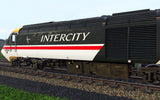In Game Downloadable Content (Requires Internet Connection)
Compatible with: Trainz Plus TRS22Following on from the classic blue and yellow BR Intercity 125 livery, British Rail introduced the 'InterCity Executive' and then 'IntertCity Swallow' liveries. Jump aboard and whisk your passengers across the countryside with these classic HST liveries, bringing a more formal and modern look to your services!
The BR HST - InterCity Executive and InterCity Swallow set includes the two classic 1980s and 1990s BR HST liveries, with 7 and 8 car set consists.
Each vehicle modeled in exquisite detail with breathtaking interior views.
Special features include:
• Power Car Names
• Weathering options
• Day/Night Headlights
• Markers and tail lamps
• Interior lights
• Exhaust deflector options
• Cooling group options
• Guard window options
While Dr.Beeching is remembered by many for recommending the closure of dwindling branch lines, it's often overlooked that his vision included critical investment in the railway's strengths. The concept of focusing passenger traffic on High-speed inter city services would alter the eroded perception of rail in the UK and bring travelers back from the burgeoning motorways.
During the late 1960s BR began developement of an Advanced Passenger Train introducing complex active tilting technology. The APT concept was intended to provide a comfortable ride at high speeds over the twisting alignments of a network established in the 19th century. An ambitious project and while BR remained committed, by 1970 it was evident that the diverse range of innovations would not deliver desperately needed modernisation in a timely manner. Parallel developement of a more conventional high-speed diesel train was authorised as an interim measure.
A push-pull, fixed formation multiple unit concept was adopted, generating the 4,500 horsepower required to operate continuously at the proposed 125mph. The pair of light-weight 'power cars' would provide sufficient power for a low axle load, limiting wear on plant at sustained high-speed operation. A driving cab at each end would streamline turnarounds at terminal stations. Newly developed disc brakes would stop the train from 125mph within existing signal intervals; rapid acceleration and deceleration being critical to reducing journey times.
A prototype formation was completed in 1972 and trial running pretty quickly satisfied of the concept. Industrial designer Kenneth Grange was hired to create the livery and took the initiative to offer further developement of the styling. Wind tunnel testing was undertaken at Imperial College and helped to improve the aerodynamics. Some union hesitation also influenced the power car's appearance, particularly regarding the single driving position with no place provided for a secondman. BR being impressed with Grange's work thus far it devolved upon him to accommodate a larger windscreen and cab side windows. It was also decided that as fixed formations, traditional buffers would not be required and this importantly allowed for the longer, more aerodynamic rake of the iconic nose cone.
Production series train sets were delivered from 1975, entering service firstly on the Western Region and sporting the new Inter-City 125 branding. Despite some early teething troubles the introduction of the HST was a marked improvement in services and a commercial success. Passenger numbers rose wherever they were introduced, especially on the ECML where they quickly displaced the Deltics and significantly reduced journey times. The HST was bringing travelers back to rail, shoring up the survival of cross country services. Successive orders were placed for additional sets.
While representing a marked improvement in passenger comforts, accommodations for the guard inside the power car did prove noisy and unsuitable. Under union pressure, HSTs ordered from December 1979 had the guard's compartment moved out of the power car into modified Trailer Second vehicles, designated Trailer Guard Second (TGS). Power cars 43153 and onwards were then distinct in lacking the rear guard compartment windows.
As the UK moved into the 1980s, a new look was introduced with the British Railways 'Inter-City Executive' livery, moving from the blue/yellow livery to a classy grey yellow and white livery! In 1987, a new style was then introduced using a similar colour palette, but with new lettering and the 'Swallow' logo replacing the previous 'Double Arrow' logo.
Conceived to bridge a gap in BR's plans for modernisation and buy time for ATP developement; the HST carried the flag for the Inter City network probably beyond the wildest dreams of it's designers. Various modifications and refurbishments enabled the iconic veterans to remain in service well into privatisation.
After 4 decades the Inter-City 125 era finally drew to a close on the National Rail network in 2019. ScotRail continues to maintain some 20 HST sets refurbished to modern requirements by Wabtec in Doncaster for services linking Scotland’s major cities. Locomotive Services Limited have modified an HST set in the style of the 1960s Midland Pullman. The eye catching all First Class train has delighted enthusiasts; the sight of an HST on the National Rail network not altogether a thing of the past.
We trust you'll join us in thanking... Ilya for the stunning original artwork. Brendan for contributing handsomely with scripting, additional art and intuitive sensibility for all things Trainz. Plus the 125 Group for their excellent owner's manual and patient assistance with hard questions.
| Platforms Supported: | PC & MAC |






















